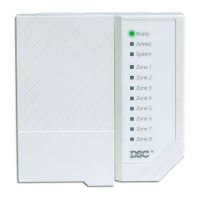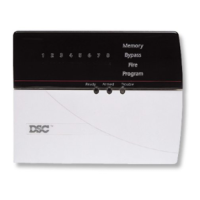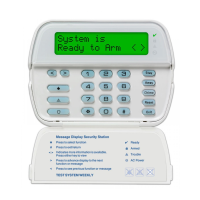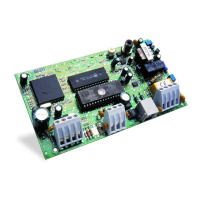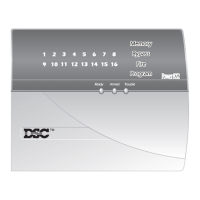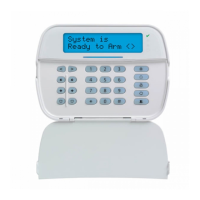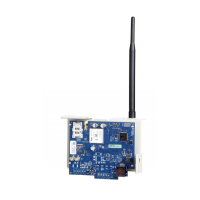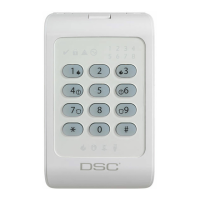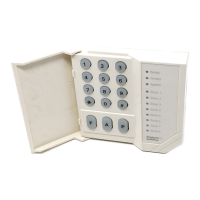18
Communicator Enable/Disable . . . . . . . . . .Section [380]: [1]
Communicator Call Direction Options . . . Section [361]-[368]
Force Dialing . . . . . . . . . . . . . . . . . . . . . . . . Section [702]: [2]
Delay Between Dialing Attempts. . . . . . . . . . . . Section [703]
Busy Tone Detection . . . . . . . . . . . . . . . . . .Section [701]: [6]
Maximum Dialing Attempts . . . . . . . . . . . . . . . . Section [160]
Post Dial Wait for Handshake . . . . . . . . . . . . . . Section [161]
Pulse Dialing Make/Break Ratio . . . . . . . . .Section [702]: [1]
ID Tone Enabled . . . . . . . . . . . . . . . . . . . . . Section [702]: [5]
2100Hz/1300Hz ID Tone . . . . . . . . . . . . . . . Section [702]: [6]
Bell on FTC/Trouble Only . . . . . . . . . . . . . . . Section [702]: [8]
5.7 Communicator – Account Numbers
The account number is used by the central station to distin-
guish between panels. There are two account numbers pro-
grammable for the PC1565.
First Account Code (4 digits) . . . . . . . . . . . . . . Section [310]
Second Account Code (4 digits) . . . . . . . . . . . Section [311]
5.8 Communicator – Telephone Numbers
The panel can use three different telephone numbers for com-
municating with the central station. The First Telephone
Number is the primary number, the Second Telephone Num-
ber is the secondary number and the Third Telephone Num-
ber will back up the First telephone number if enabled.
NOTE:The Third Telephone Number will NOT back up the Sec-
ond Telephone Number.
NOTE: If you enter a telephone number section (sections [301]
- [303]) at an LED keypad, pressing [#] will delete the pro-
grammed telephone number and change all the digits to [F].
If the Alternate Dial option is enabled, the panel will alternate
between the first and third telephone numbers when attempt-
ing to call the central station. If the option is disabled, the
panel will only attempt to call the Third telephone number after
failing to communicate with the first telephone number.
NOTE:To use the Third Telephone Number, you must enable it
in section [380], option [5], and program it in section [303].
NOTE:Telephone numbers can be up to 32 digits. This allows
you to add special digits if required. To program the telephone
number, enter the numbers 0 through 9 as required. The fol-
lowing is a list of programmable Hex digits and the functions
they perform:
Hex (B) - simulates the [*] key on a touch tone telephone
Hex (C) - simulates the [#] key on a touch tone telephone
Hex (D) - forces the panel to search for dial tone
Hex (E) - forces the panel to pause for 2 seconds
Hex (F) - marks the end of the telephone number
NOTE:The first digit of all telephone numbers must be the Hex
digit ‘D’ for dial tone search, or two Hex ‘Es’ for a 4-second
pause.
First Telephone Number . . . . . . . . . . . . . . . . . . Section [301]
Second Telephone Number. . . . . . . . . . . . . . . . Section [302]
Third Telephone Number. . . . . . . . . . . . . . . . . . Section [303]
Third Telephone Number Enable. . . . . . . . .Section [380]: [5]
Alternate Dial . . . . . . . . . . . . . . . . . . . . . . . . Section [380]: [6]
5.9 Communicator – Reporting Codes
The panel can be programmed to report events to the central
station by sending the Reporting Code programmed for a
particular event.
Reporting codes can be one or two digits and can use Hex
digits (A through F). For a complete description of reporting
codes which can be programmed and lists of automatic Con-
tact ID and SIA format codes, please see Appendix
A: ‘Reporting Codes’ on page 44.
NOTE:Do not use the digit C in a reporting code when using
Pager Format. In most cases, the digit C will be interpreted as
a [#], which will terminate the page before it has finished.
Reporting Codes. . . . . . . . . . . . . . . . . .Section [320] to [353]
Cross Zone Police Reporting Code
The Cross Zone Police Code Alarm will be sent when two
different alarms occur during any armed-to-armed period.
When an alarm occurs while the panel is armed and a second
alarm occurs on a different zone during the same armed
period, or after the system is disarmed, this code will be sent.
All zone types contribute to this alarm. The cross zone police
code will be transmitted immediately unless either or both
zones have the Transmission Delay attribute enabled. If so,
the code will be delayed for the programmed transmission
delay time.
Cross Zone Police Code Alarm . . . . . . . . . . . . Section [328]
Zone Restorals
If the Restoral on Bell Time-out option is selected, the panel
will send the Zone Restoral Reporting Code for the zone if
the bell cut-off time has expired and the zone is secured. If the
zone is not secured when the bell cut-off time expires, the panel
will send the restoral immediately once the zone is secured, or
when the system is disarmed. If the Restoral on Bell Time-out
option is not selected, the panel will immediately send the Zone
Restoral Reporting Code when the zone is secured, regardless
of whether or not the alarm output is active.
NOTE: 24-hr type zones will report the restoral immediately
when the zone is secured.
Restoral on Bell Time-out . . . . . . . . . . . . . . Section [380]: [2]
Closings (Arming Codes)
If the Closing Confirmation option is enabled, once the exit
delay expires, the keypad will sound a series of eight beeps to
confirm to the user that the closing code was sent and
received by the central station.
Closing Confirmation . . . . . . . . . . . . . . . . . Section [381]: [4]
Openings/Closings by Wireless Key
If you are using a PC5132 v3.0 or higher, wireless keys with
access codes may be identified when they are used to arm or
disarm the system: the panel will log and transmit opening or
closing by access code (the same as if an access code had
been used to arm/disarm the system). If wireless keys with no
access code are used, the event will be logged and transmit-
ted as opening or closing by keyswitch.
The Function Keys Require Code option must be selected
(section [015], option 4 OFF) in order for wireless keys to be
identified for arming. Disarming will always be logged by
access code, if one is programmed for the Key, regardless of
this option.

